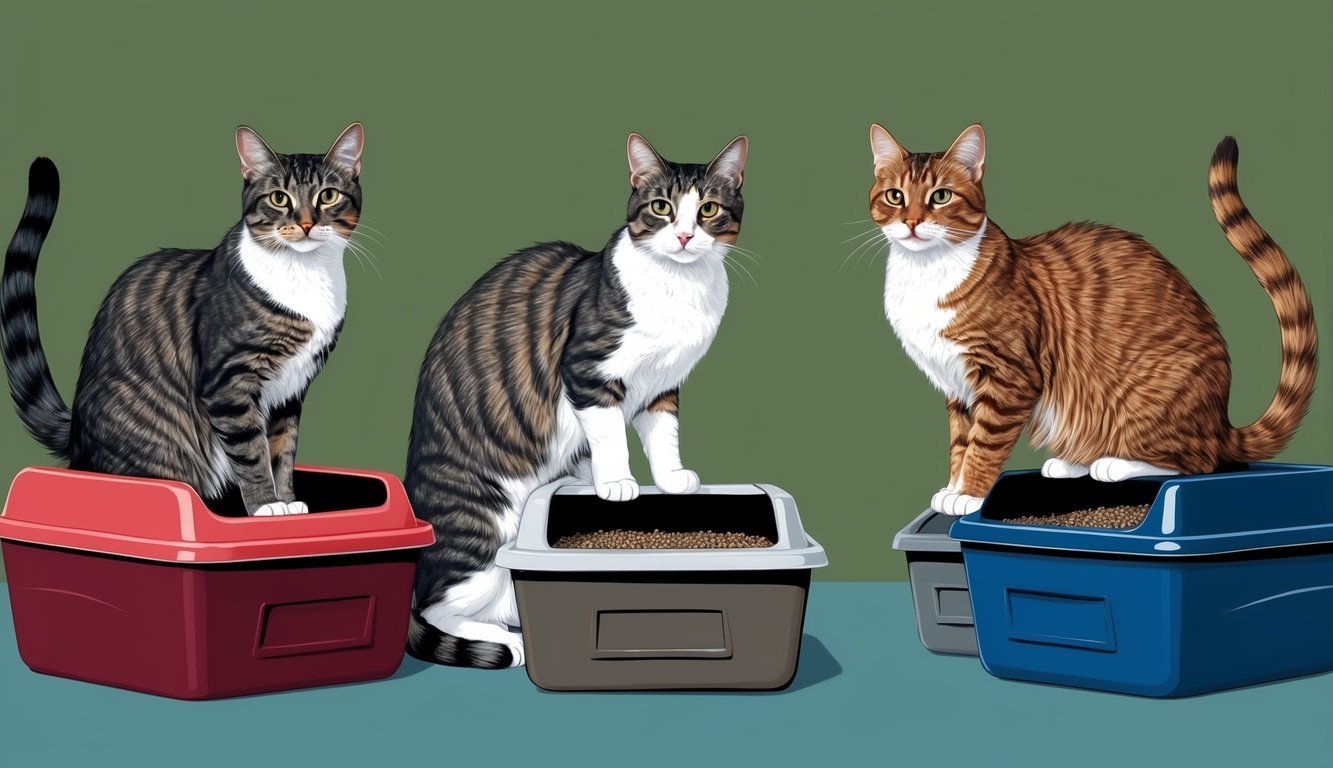When you share your home with three cats, managing their litter box needs is crucial for keeping a clean and harmonious environment. The general rule of thumb is to have four litter boxes for three cats.
This ensures that each cat has access to a clean and comfortable place to do their business without feeling crowded or stressed.
Understanding your cats’ behavior can help you prevent litter box issues and promote good hygiene.
Providing enough boxes not only accommodates their needs but also encourages healthy habits, reducing the likelihood of accidents outside the box.
Curious to learn more about the best practices for setting up litter boxes in your home?
Key Takeaways
- Aim for one litter box per cat, plus one extra.
- Choose the right type and location for each box.
- Maintain hygiene to promote healthy habits and prevent issues.
Understanding the Needs of Multiple Cats
When you have multiple cats, their needs can become quite complex.
Providing adequate litter box options is a crucial aspect of maintaining harmony in your home.
This section explores the convenience of litter boxes and the behavioral dynamics in a multi-cat household.
Importance of Litter Box Convenience
In a multi-cat household, the number of litter boxes can significantly impact your cats’ comfort.
A good rule of thumb is to have one litter box per cat, plus one extra.
This means if you have three cats, you should ideally have four litter boxes.
Placing boxes in different locations caters to your cats’ territorial instincts.
Each cat can have its own space to relieve itself without feeling anxious.
Key locations for litter boxes include quiet, low-traffic areas that allow privacy.
Benefits of convenience include reduced stress and fewer accidents outside the box.
When your cats feel secure about where they can go, you’re less likely to deal with behavioral issues such as spraying or inappropriate elimination.
Behavioral Aspects of Multi-Cat Households
Understanding cat behavior is essential when managing multiple felines.
Cats are naturally territorial animals.
If they feel their space is threatened, it can lead to anxiety or aggression towards each other.
With an appropriate number of litter boxes, you can minimize territorial disputes.
If one cat dominates a box, others might avoid using it.
This can create tension and potential behavioral problems.
Watch for signs of stress, like excessive hiding or fighting.
By ensuring that each cat has access to its own litter box, you promote healthier relationships among them.
The fewer the confrontations over resources, the happier and more balanced your home will be.
Creating a comfortable environment for your cats ultimately leads to a more peaceful living situation for everyone involved.
Determining the Right Number of Litter Boxes
When it comes to multiple cats, ensuring their comfort and hygiene is essential.
Choosing the right number of litter boxes can be a simple yet vital aspect of effective pet ownership.
Below are some guidelines to help you make the best decision.
General Guidelines for Multiple Cats
For three cats, the recommended number of litter boxes is four.
This aligns with the common rule that suggests having one box per cat plus one extra.
More boxes reduce competition and potential territorial issues among your pets.
Placement matters: Distribute the boxes in different areas of your home.
Avoid clustering them in one spot.
This accessibility makes it easier for your cats to use them without the stress of waiting for others.
Consider the size of the boxes as well. Larger boxes provide more space for gardening, which many cats appreciate.
Keeping these boxes clean is also crucial; daily scooping can significantly enhance their willingness to use them.
Adjusting to Your Cats’ Preferences
Every cat has its unique personality and preferences that can influence their litter box usage.
Pay attention to how your cats behave around their boxes.
If one cat frequently avoids a specific box, consider repositioning it or offering a different type of litter.
Monitor their habits: If you notice one cat consistently using a particular box, make sure that box remains available and clean.
Cats can be picky, and the right environment encourages them to share without anxiety.
Additionally, keep an eye on any health changes.
A sudden decrease in litter box usage could indicate a medical issue.
Always be ready to adjust the number of litter boxes or their locations to create a comfortable space for your feline friends.
Types of Litter Boxes
Choosing the right type of litter box is essential for keeping your home clean and your three cats happy.
Understanding the pros and cons of various models and the latest innovations can help you make the best decision.
Pros and Cons of Different Models
When it comes to litter boxes, a few types stand out.
Here’s a quick breakdown:
| Type | Pros | Cons |
|---|---|---|
| Open Litter Boxes | Easy access for cats, encourages natural behavior | Can allow odors to escape |
| Covered Litter Boxes | Containment of litter and odors | May feel cramped for some cats |
| Self-Cleaning Boxes | Reduces maintenance, less odor | Higher initial cost, relies on technology |
Open boxes are great for encouraging your cats to use them, but you might deal with more odors.
Covered boxes can keep things tidy but may not be as appealing for every cat.
Meanwhile, self-cleaning boxes save time in cleaning but consider the tech’s reliability.
Innovations in Litter Box Technology
Recent advancements make litter box less of a chore.
One popular option is the self-cleaning litter box.
These use sensors to detect when your cat has used them, automatically cleaning and raking waste into a sealed compartment.
Some companies have introduced app-controlled litter boxes, allowing you to monitor usage and waste levels remotely.
This can help you track litter consumption and ensure your cats are using their boxes regularly.
For multiple cats, consider models specifically designed for several users.
Boxes that prevent odors and has multiple compartments can make a significant difference in maintaining a clean environment.
Choosing the right type not only keeps your space tidy but also respects your cats’ preferences.
Choosing the Right Location

The placement of litter boxes is crucial for your cats’ comfort and well-being.
Proper location can help reduce stress and make the boxes more appealing.
Here are essential strategies to consider when finding the right spot for your litter boxes.
Strategic Placement for Comfort and Privacy
When setting up litter boxes, think about your cats’ need for privacy.
Cats prefer to feel secure while doing their business.
Aim to place each box in a quiet area away from loud noises and disruptions.
Consider using corners or less trafficked rooms, such as a laundry room or bathroom.
You might even install a small cover on some boxes to give your cats extra seclusion.
Make sure the boxes are easily accessible but not in the main flow of household activity.
Cats often like to have some distance from where their food and water are placed.
Avoiding High Traffic Areas
It’s crucial to avoid placing litter boxes in high traffic zones.
Cats don’t like feeling vulnerable while using the box, and constant foot traffic can discourage them.
Try to keep litter boxes away from areas like hallways or living rooms where family members frequently pass through.
Also, consider other pets in the home.
Keep the boxes out of reach from dogs or curious pets that might invade your cats’ space.
This helps maintain a calm environment that encourages your cats to use their boxes without hesitation.
Maintaining Litter Box Hygiene
Keeping your cats’ litter boxes clean is essential for their health and well-being.
Regular maintenance can prevent a host of litter box issues, such as odor and unwanted behavior.
Here are some tips to help you maintain hygiene:
-
Scoop Daily: Remove waste daily to keep boxes fresh. This practice prevents odors and encourages your cats to use the boxes consistently.
-
Choose the Right Litter: Select a litter that clumps well and absorbs moisture. This helps control odors and makes cleaning easier.
-
Wash the Boxes: Clean the litter boxes weekly using a pet-safe disinfectant. Scrub with warm water to remove any stuck debris.
-
Rinse Thoroughly: After cleaning, rinse the boxes well to ensure no cleaning residue remains. Cats can be sensitive to scents and chemicals.
-
Ensure Good Location: Place the litter boxes in quiet, accessible areas. If a box is hard to reach, your cats may avoid it, leading to health issues.
-
Monitor Health: Keep an eye on your cats’ habits. Changes in litter box usage can indicate health issues that warrant a vet visit.
By following these steps, you’ll create a pleasant environment for your cats, minimizing discomfort while promoting their health.
A clean litter box also helps foster positive litter box behaviors.
Preventing and Addressing Litter Box Problems
Managing litter box issues can help ensure a harmonious home for you and your cats.
By addressing common problems like spraying and territorial conflicts, you can create a more comfortable environment for all your pets.
Dealing With Spraying and Marking
Spraying and marking are often linked to territorial issues among cats.
This behavior can escalate when you introduce new cats or when there’s a significant change in their environment.
To minimize spraying:
- Ensure Enough Litter Boxes: For three cats, aim for four litter boxes to accommodate everyone’s needs.
- Create Safe Spaces: Designate areas where each cat feels secure. High perches or cozy hideouts can help.
- Use Pheromones: Consider using feline pheromone diffusers to reduce stress and anxiety.
If spraying continues, consult with a veterinarian or a cat behaviorist for additional strategies tailored to your situation.
Resolving Sharing Conflicts
When multiple cats share the same space, conflicts can arise around litter boxes.
This is often due to competition for resources.
Here are steps to follow:
- Multiple Access Points: Keep litter boxes in different locations to prevent territorial disputes.
- Regular Cleaning: Clean each box daily. Cats are less likely to use a dirty box, which can lead to accidents elsewhere.
- Monitor Behavior: Observe interactions among your cats. If one seems dominant, ensure the others have access to their own space.
Frequently Asked Questions

When managing a multi-cat household, there are several important considerations regarding litter boxes.
Addressing common questions can help ensure you create a comfortable environment for your feline friends.
What’s the ideal number of litter boxes for a multi-cat household?
For three cats, the recommended number of litter boxes is four.
This follows the guideline of having one litter box for each cat, plus an additional box.
Having this extra option reduces competition and can help prevent litter box issues.
Can too many litter boxes cause issues in a home with three cats?
Yes, sometimes too many litter boxes can lead to problems.
If boxes are too close together or not cleaned regularly, your cats might avoid using them.
It’s important to place them strategically around your home.
What’s the scoop on the best litter box setup for three feline friends?
A good setup includes placing boxes in different locations throughout your home.
This ensures that each cat has access to a litter box even if others are occupied.
Consider using different styles of boxes to cater to each cat’s preference.
How often should the litter boxes be cleaned in a three-cat family?
You should clean the litter boxes daily.
Scoop out waste and clumps every day to keep the boxes fresh and odor-free.
A complete wash of the boxes should be done weekly to maintain hygiene.
Is there a formula to calculate the number of litter boxes per cat?
A straightforward formula for litter boxes is one box per cat plus one extra.
For three cats, that results in four litter boxes.
This approach helps prevent territorial disputes over the boxes.
Does the type of cat litter matter when maintaining multiple boxes?
Yes, the type of cat litter can significantly impact your cats’ willingness to use their boxes.
Opt for litter that absorbs odors well and is comfortable for your cats.
Experiment with different types to see what your cats prefer.


